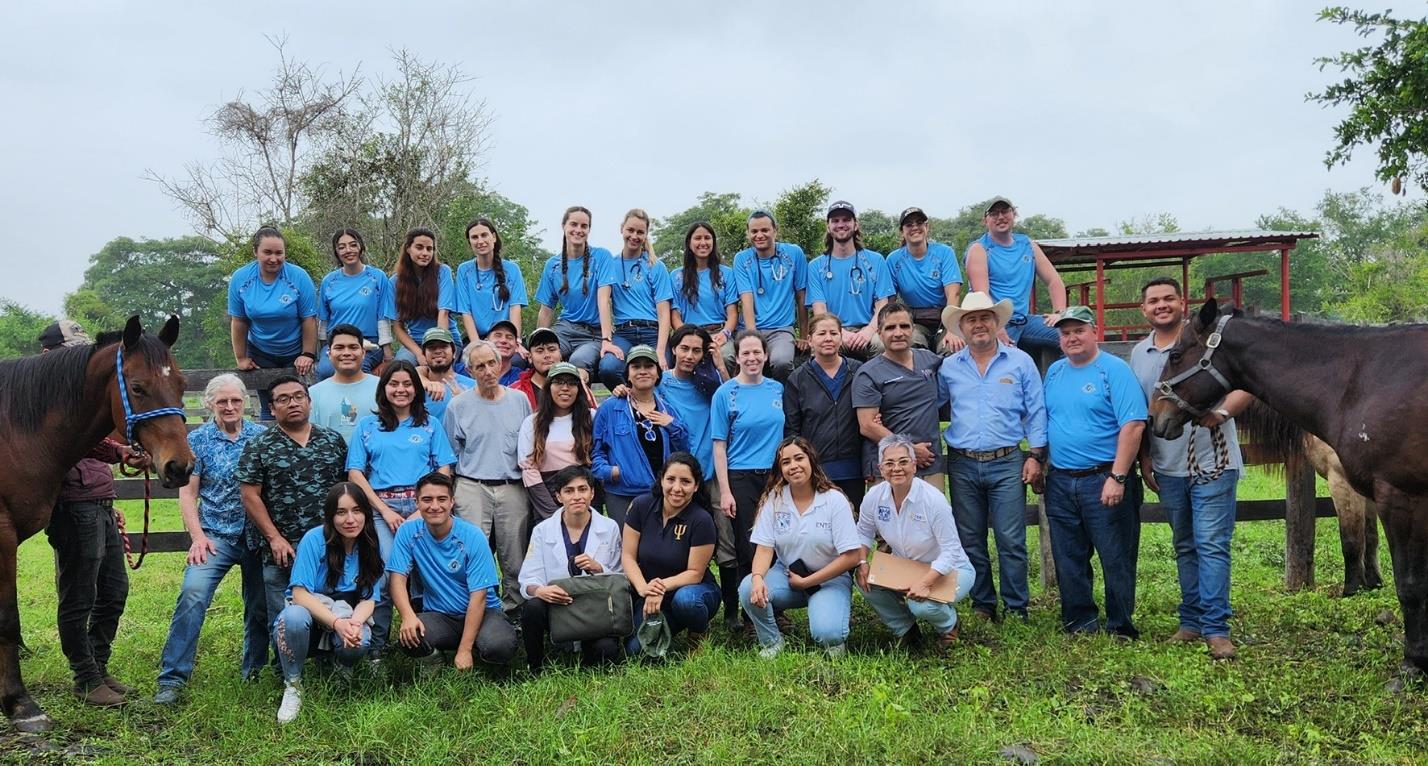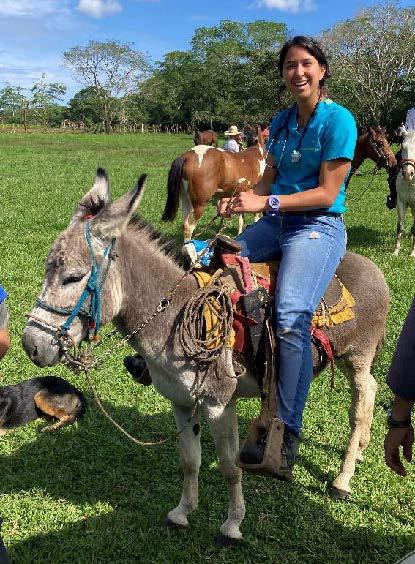Equine Welfare in Practice is a practical learning experience where students travel to various regions in Mexico and provide equine veterinary services to locals in collaboration with Universidad Nacional Autónoma de México UNAM and Universidad Veracruzana UV.
“Since 2017, 46 MSU students, and similar numbers of UNAM and UV students have participated in the clerkship. Many participants are now equine practitioners, and it was a pleasure to have Dr. Megan Ahearne join as faculty this year, as she participated in the clerkship as a student in 2019,” says Dr. Hal Schott, professor of large animal clinical sciences and instructor for the clerkship.
“This program is a true collaboration between veterinary schools in the US (faculty from MSU and the University of Tennessee) and Mexico (UNAM and UV), as well as private equine practitioners in Michigan including Dr. Jeff Bunn, Dr. Lauren Fischer, Dr. Kelsey DeLand, Dr. Gail Hoholik, Dr. Matthew Davis, Dr. Greg Crosley and Dr. Ahearne.”
Journal entries from participants in the clerkship highlight how students grow from the experience of hands-on learning in a new setting.
Day 2: Shelby Rivkin
This was our first full day in Mexico City. We headed to UNAM for a tour of the main campus. Afterward, we headed to Mexico City’s central city square. The square is bordered by government buildings, shops, and the cathedral. Our tour included education about Aztec and Spanish cultures, a tour of the pyramid ruins in the square, and a detailed tour of the Templo Mayor museum.
Day 3: Kylie Owen
We met up with the UNAM students and loaded our vans for the seven-hour journey to Centro de Enseñanza, Investigación, y Extensión en Ganadería Tropical. A couple of rest stops along the way allowed us to befriend local perros. We stopped in Casitas for a lovely dinner on the Gulf Coast where we were serenaded by a mariachi band and enjoyed fresh local seafood. Once we headed back to our hotel, we fell fast asleep to rest up for the week ahead!
Day 4: Kay Johnson
Our first stop at the ranch was the dairy milking parlor. We got to see them milk the cows and Mariano explained to us that they were researching cross-breeds of dairy cattle for the highest milk yields in hot climates. We sampled some of their famous delicious cheese! As we were setting up for the day, local farrier was ready for us with his horse. Dr. Mariano went through our examination process for working equids and all the students took their time examining his grey gelding. That was followed by Dr. Schott’s mini-rounds on cardiac sounds. The farrier’s gelding was in great shape; it just needed vaccines and a dental float.
Day 5: Valerie Carle
We learned how an equid’s dental health maintenance is critical for their healthcare. Also, taking history with an attention to detail can help give clues on the need for dental work. We discussed the importance of a thorough physical exam and, most importantly, assessing the patients’ circulatory system — we need to take into consideration any abnormalities found on auscultation since most procedures we would be performing require sedation. In the case we find a patient with a problem, we can adjust the sedation protocol to assure their safety.
Day 6: Joseph Klein
Today we saw some interesting cases including a bilateral swelling behind the poll (likely a nuchal bursitis from a rope halter), a couple of hindlimb lameness cases, one with an unusual firm swelling above the hock, and a few sick, thin horses with anemia.
Day 7: Mitchell Susalla
Today unfolded with lots of activity as we entered Colipa. Horses, mules, and donkeys in need greeted us as we arrived. The day's agenda involved an examination of nearly 100 animals (the most we have done in one day this week), each with its unique tale of resilience and hardship.
Day 10: Miguel Catala
We loaded back up into the UV bus and headed south to Los Tuxtlas — an UNAM rainforest research station in southern Veracruz state — along the coast about 3 hours south of Veracruz city. This was to be our dormitory lodging and cafeteria for the next week. The center hosts researchers and students for various activities and is an important conservation center for Mexico. There are 126 mammal species with 60 percent being bats.
Day 11: Kay Johnson
We all woke up in the early morning hours to heavy downpouring of rain. Fortunately, the rain stopped by breakfast time, and the howler monkeys and birds were our alarm clocks. Breakfast was delicious and we all enjoyed the fresh fruit and a dish prepared by the kitchen. It took a few horses for my partner, Yamileth and I to get in a groove checking in horses but once we got going, we were a well-oiled machine.
Day 12: Kylie Owen
Dr. Fischer befriended a couple of young girls at the dentistry station who were quite interested in what we were doing. She showed a couple of them how to listen to a horse’s heart with her stethoscope — perhaps future veterinarians!
Day 13: Shelby Rivkin
At the farrier and dentistry stations, the faculty were standing back and observing as the students were honing their skills — it was nice to see the faculty appreciating how much we had advanced our skills and confidence.
Day 14: Angélica Torres-Rodríguez
As the day progressed, we performed 15 hoof trims, 15 dental floats, and 8 castrations, including a cryptorchid. We were all gaining more skills and had become quite competent and efficient with these procedures, and our confidence in our abilities increased each day.
Day 15: Joseph Klein
By about 3:00 p.m. we had seen more than 50 equids and one pig. Saúl, one of the UV students who had joined our team for the second year, worked on befriending several foals before vaccinating them. Seeing the team tackle every patient efficiently on this last day felt like we were a well-oiled machine. This two-week experience clearly increased everyone’s skill and confidence at each station. Further, we approached the work with a team effort; from each procedure, anesthesia, and dental, down to wrangling foals for vaccination and deworming. Before we knew it the day was over.
To read the journal entries in full detail, explore the collection.
This story originally appeared on the Veterinary Medicine website.







